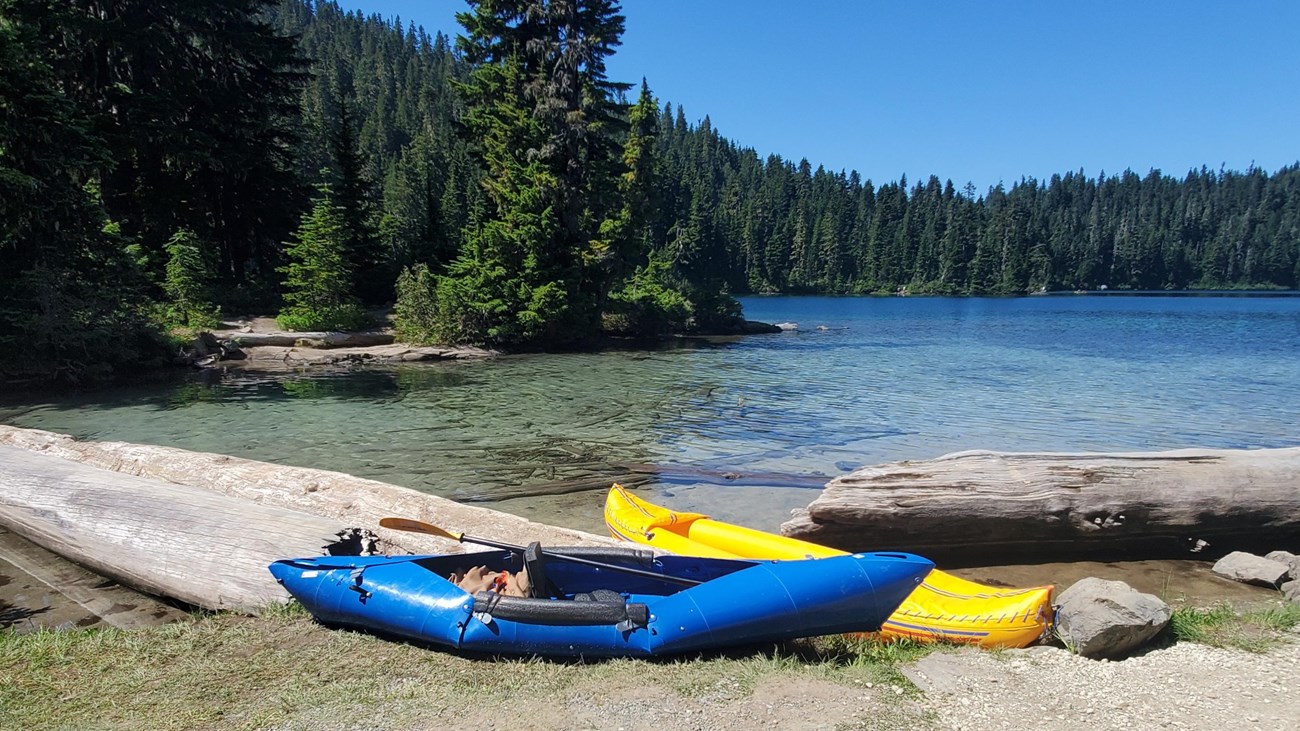Last updated: November 9, 2022
Thing to Do
Paddle Sports at Mowich Lake

NPS/M. Meitle Photo
Paddle sports refers to increasingly popular human-powered small watercraft activities. This blanket term includes but is not limited to canoeing, kayaking, rafting, and stand-up paddle boarding. Because these watercraft are typically smaller than 10 feet, they do not require a state boating license. Because they are human-powered, they are permitted in the federally designated wilderness areas that make up 97% of Mount Rainier National Park. This means paddle sports offer a unique opportunity to get out on the water and experience the truly isolated lakes that are scattered across Mount Rainier.
The main obstacle to paddle sports in Mount Rainier National Park is access. All of the lakes that visitors are permitted to recreate on are relatively remote. Modern technology has made watercraft increasingly lightweight and portable. While some watercraft are inflatable, foldable, or packable, at the end of the day getting to the edge of a lake with the requisite equipment remains a challenge. This challenge is what preserves the unique wilderness experience of these remote lakes.
All lakes in Mount Rainier National Park are open year-round except those listed below. Accessing lakes during the winter can be very challenging, when many roads close for the season, and lakes are often frozen and snow covered. The following lakes are closed year-round to protect sensitive riparian vegetation:
-
Tipsoo Lake
-
Shadow Lake
-
Reflection Lake
The following lakes are closed year-round to protect water supplies:
-
Frozen Lake
-
Ghost Lake
Mowich Lake is the largest lake in the park and is one that you can both drive to and recreate on, but even here visitors should be prepared to move their equipment over uneven terrain. On the busiest summer weekends, parking limitations might force you to park half a mile or more from the lake shore. Mowich Lake has its own park entrance via SR165 in the northwest corner of the park, which takes time to drive to. Stop by the Carbon River Ranger Station at nearby Carbon River before heading up to the lake for maps, information, and wilderness permits if you are planning to camp overnight.
Safety is important when engaging in paddle sports. Water is always dangerous and Mount Rainier's cold mountain lakes are never warm even on the hottest summer days. Because of how isolated the park lakes are, visitors need to be able to self-rescue. This is not the time or place to test new equipment or learn new skills. Always wear a Personal Flotation Device on the water and have a dry change of warm clothes to change into if necessary. Be prepared to make minor repairs to your equipment. Carry food, water, sunscreen, and bug spray.
Preserve the lakes. Thoroughly wash and dry all equipment before and after visiting Mount Rainier National Park to prevent the transport of non-native or invasive species between lakes. Pay special attention to removing mud or vegetation that might be attached to your gear, including clothing and shoes. Do not dump any water from other sources into Mount Rainier National Park waters. Each lake is its own fragile ecosystem and it is up to all of us to help keep it that way.
There are no designated areas along the shore of Mowich Lake to launch water craft. Please avoid trampling meadow plants and other vegetation along the shore and limit your impact when visiting any park lake.
Pets are not permitted on any park trails, including around Mowich Lake.
With these simple instructions in mind, you are ready to enjoy a lake experience at Mount Rainier National Park!
Mowich Lake is the northwest corner of Mount Rainier National Park via State Route 165. The road is unpaved after the first three miles and may be rough. Mowich Lake Road is open during the summer season only, typically mid-July to October.
